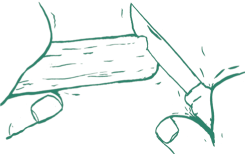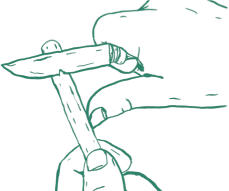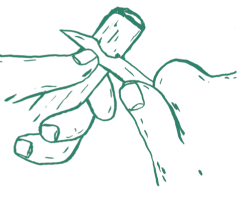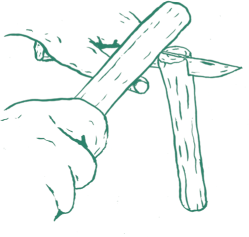Carving Techniques
When it comes to whittling, techniques tend to vary from person to person. Safety is the key element to consider however, and is perhaps the overriding factor dictating the composition of each cutting stroke. The following examples, each featuring important safety tips, demonstrate a series of fairly basic cutting techniques. The illustrations relate to carving with wood, but most can be applied to the other materials used in this book, be they cork, carrot or cucumber.

Stop cut
The stop cut is perhaps the simplest of the strokes and covers a multitude of actions. Essentially it is an exertion of downward force on the blade in order to indent or mark your material, and is typically used to create an initial guiding imprint or a point to which you can subsequently carve. It is advisable to place your whittling project on a hard surface before making a stop cut to add stability.

Paring cut
This is the traditional cut used for cutting an apple: with the apple in one hand, the knife handle is gripped firmly in the other. Using the thumb of your knifed hand to steady the action, draw the blade inwards towards the thumb. The stroke itself encourages a swivelling motion in the wrist, lifting the blade as it travels, and delivering a smooth and shallow cut. The safest way to make a cut like this is to tuck both the fingers and thumb out of the way, ideally underneath the whittled object. You can also wear a protective glove or thumb guard.

Push cut
This is an invaluable technique when it comes to carving with accuracy, allowing the whittler to achieve delicate and ornate results. By using the thumb of your un-knifed hand to exert force on the blade, a steady cut can be made, be it long or short in length. This carving technique is also particularly safe as it offers maximum control, with the blade aimed away from the body. Use a push cut to round off edges and carve notches into wood.

Pull cut
With the penknife held in position, use your other hand to administer the cut by drawing your whittled object towards the blade. Again, this is a safer form of cutting technique, keeping the blade pointing outwards and locked in a fixed position.

Split cut
This cut is used to split, cleave or ‘rive’ a straight-grained piece of wood. Stand a stick or straight branch on a flat surface with your blade placed at its centre. Using a piece of heavy wood, knock the knife downwards.




